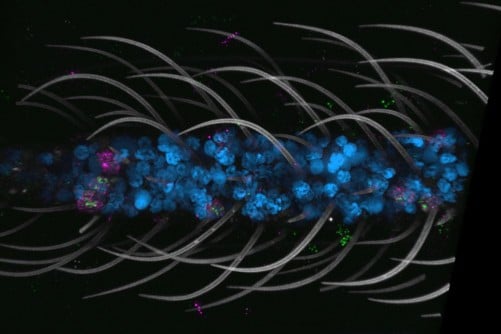A team of researchers from Rockefeller University has released the world’s first cellular atlas of the Aedes aegypti mosquito, a species known for transmitting more diseases than any other mosquito. This groundbreaking work, published in the journal Cell, provides comprehensive insights into the gene expression of every mosquito tissue, from antennae to legs. The Mosquito Cell Atlas is now freely available to researchers and the public, offering a resource that could enhance future studies on disease transmission and mosquito biology.
Led by Leslie Vosshall, head of the Laboratory of Neurogenetics and Behavior, this project represents nearly two decades of research into the Aedes aegypti, often referred to as the yellow fever mosquito. Vosshall describes the atlas as a significant achievement, stating, “This is a comprehensive snapshot of what every cell in the mosquito is doing as far as expressing genes.” The project also involved global collaboration with mosquito experts, which has led to new discoveries about the genetic characteristics of both male and female mosquitoes.
The atlas reveals previously unknown cell types and highlights unexpected similarities and differences in gene expression between the sexes. Notably, the female mosquito’s brain undergoes substantial genetic changes after feeding on blood, altering its behavior dramatically. Nadav Shai, a senior scientist involved in the study, anticipates that this extensive dataset will propel mosquito biology forward, stating, “It’s a great tool for vector biologists to take whatever interests them and just run with their own line of research.”
Organ by Organ: A New Understanding of Mosquito Biology
In recent years, scientists have employed single-cell sequencing techniques to map gene expression in various model organisms, including fruit flies and mice. However, research on mosquitoes has largely been fragmented, focusing on individual organs or tissues. The Aedes aegypti Mosquito Cell Atlas Consortium aimed to consolidate this information into a cohesive resource using advanced sequencing technology.
The team utilized single-nucleus RNA sequencing (snRNA-seq) to analyze over 367,000 nuclei from 19 types of mosquito tissues, encompassing five biological themes: major body segments, sensation and host seeking, viral infection, reproduction, and the central nervous system. This comprehensive approach has uncovered 69 cell types, categorized into 14 major cell categories, many of which had never been documented before.
One of the most intriguing findings is the discovery of polymodal sensory neurons, which can detect various environmental cues such as temperature and taste. While previous studies focused on the antennae and maxillary palps, the researchers found these sensory neurons distributed throughout the mosquito’s body, including in the legs and mouthparts. “Together they enable mosquitoes to be really good at what they do—seek hosts, feed on them, and reproduce,” Shai explained.
Future Research Directions and Implications
The atlas also highlights significant changes in the female mosquito’s brain after blood feeding. Research indicated that glial cells, which make up a small portion of the brain’s cellular makeup, undergo dramatic shifts in gene expression during this time. “That was a big surprise,” Shai remarked, emphasizing the importance of glial cells in not just supporting brain function but also in influencing behavior.
Interestingly, despite the notable physical and behavioral differences between male and female mosquitoes, their cellular structures are largely similar. The researchers found that while most cells appeared the same, the regulation and levels of gene expression could lead to different functions. One exception was identified in the male antenna, where a unique gene expression was found that does not occur in females.
Looking ahead, Vosshall’s lab plans to leverage the insights gained from the atlas to explore various aspects of mosquito behavior, including host-seeking and environmental sensing. The sheer size of the dataset opens numerous avenues for future research, previously unavailable due to the lack of a comprehensive resource. “We’re excited to see the discoveries that will come from it,” Vosshall concluded.
This extensive research project underscores the potential of the Mosquito Cell Atlas as a vital tool for researchers worldwide, providing critical data that could ultimately lead to advancements in understanding and controlling one of the most dangerous animals on the planet.







